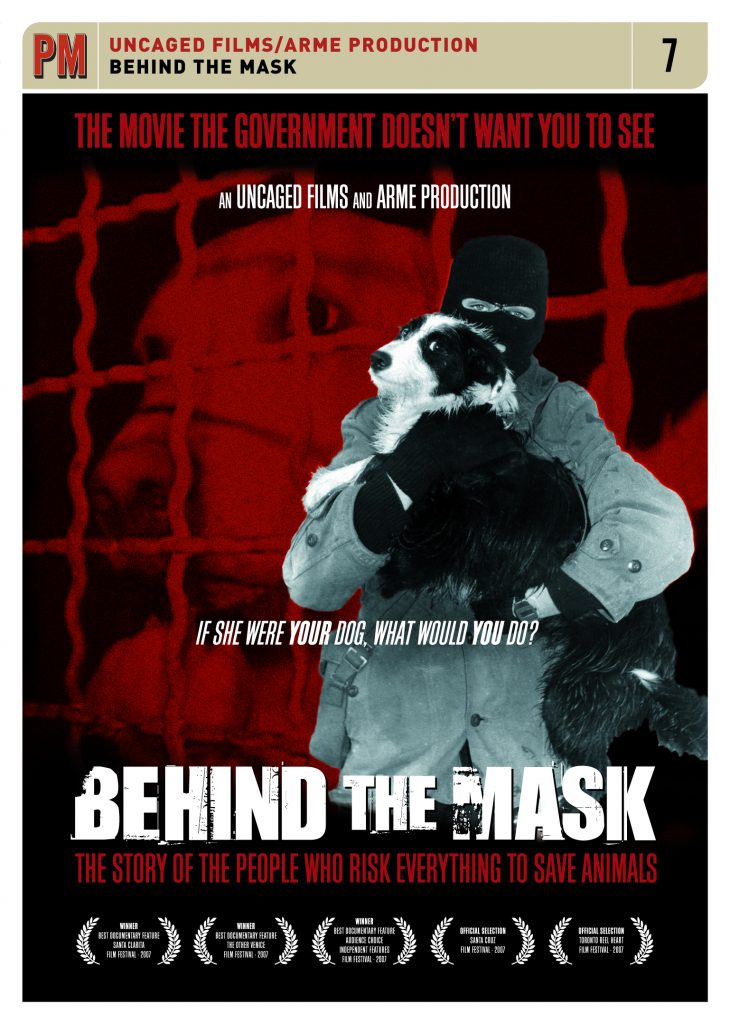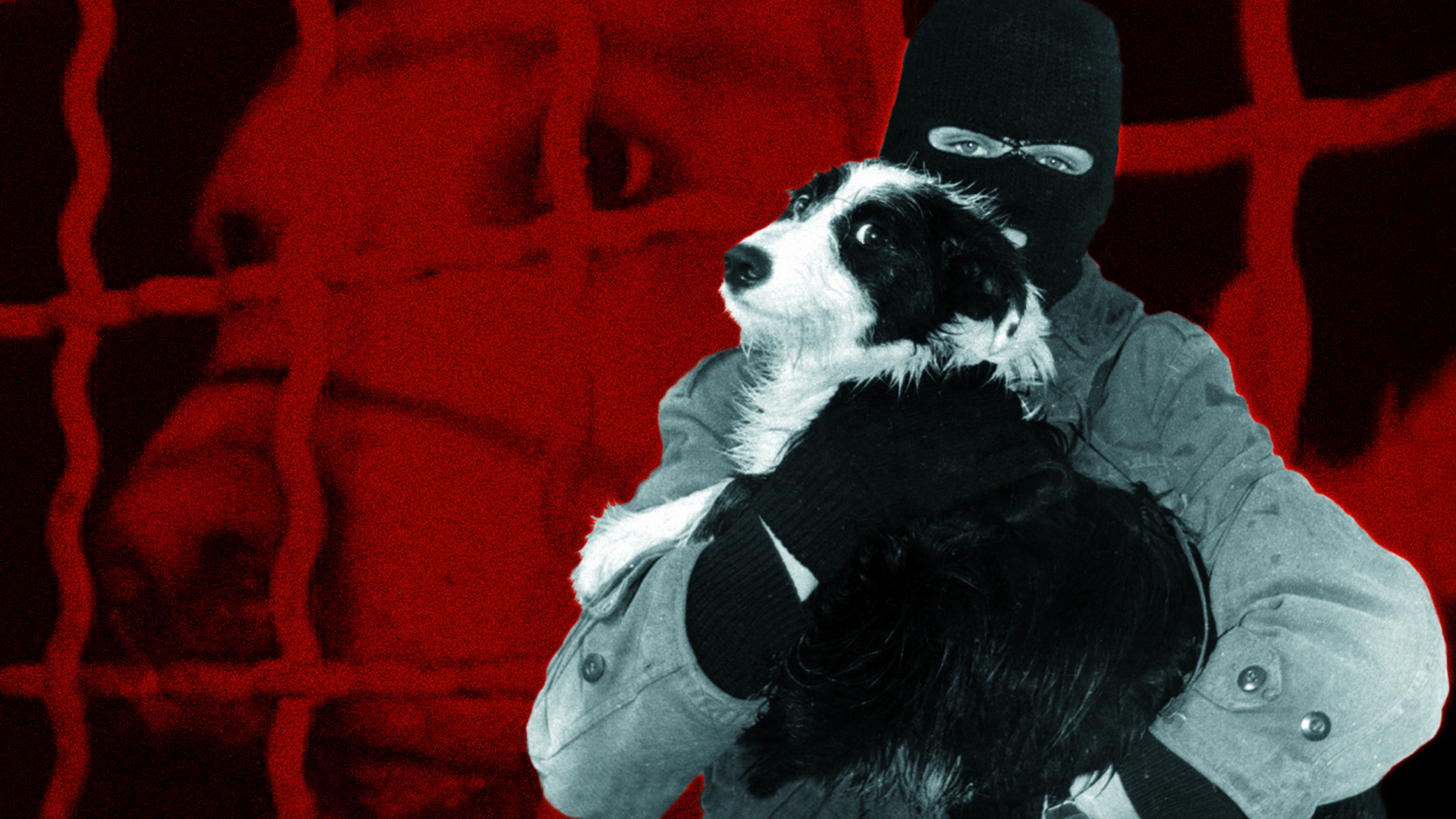
Vivisection.info Shannon Keith’s documentary Behind The Mask is a well constructed film that aims to ‘humanise’ the much maligned animal rights activist and to explicate the direct action wing, so to speak, of the animal rights movement.
It is not, as I expected, a simple juxtaposition of content but a synthesis of various resources – historical clips, interviews with noted activists, etc. – that aims to chronicle animal liberation.
Shannon, though, does not restrict herself solely to those who act extra-legally but includes voices from those who have, for one reason or another, faced repression from the state. It is strictly of the animal liberation cannon.
Although the participants ‘tell their own story’ – so Melanie Arnold, for example, discusses her slaughterhouse arson, a “successful operation” – Shannon has so edited the documentary that this personal recounting contributes to an understanding of the animal rights movement in general. We learn not only about particular incidents (which would be interesting but ultimately sterile) but about the larger context in which these occurred. The editing, the choice of material, etc., is to be praised for granting a twin insight, as it were, into the time bound and the transcendent: we learn about certain activists and something far greater simultaneously. Whereas much animal rights material merely threatens to say something interesting, Shannon’s work is as provocative as it gets.
Her basic thesis, after all, is that animal liberation – breaking into laboratories, etc – is justifiable. Viewers (and readers of this short review) are free to disagree with this [01]. Her documentary seems to have a dual purpose. She not only shows that the demonisation of certain ‘extremists’ is, in general, misplaced but she also examines how that erroneous demonisation has become the principle weapon which animal abusing industries (and their servant western governments) use to combat peaceful, law abiding activists.
Animal activists are not the ‘thugs’, the ‘monsters’, the malestream media so glibly dismisses them as. This explains the call to lift masks. Needless to say ‘mask’ has more than one meaning. Shannon’s work does, literally, show us behind the balaclava’s – the faces behind noted lab. raids, etc. But only superficially, I think, is her work about lifting ‘their’ masks. I would argue that its real purpose is to lift our own masks. Or, if you prefer, those of society. It is a call for a rejecting of the masks of demonisation – the vicious stereotypes and caricatures that have come, over the last five years, to cover, to conceal, to obscure, the real motivations for direct action in the animal rights community through a lazy discourse of ‘terrorism’.
Behind the Mask is not so much a challenge to the direct activists involved as it is a challenge to the viewer: if you genuinely believe that animal suffering matters, as we all profess to, how can you condemn those who seek to stop it through peaceful, but illegal, means? How can you – without wedding yourself to double standards – reject interpersonal cruelty toward animals but uphold institutional cruelty? As I have put it elsewhere: why is it regarded by society as wrong to stamp on the tail of a single cat but it is ‘acceptable’ to skin alive countless million mink for their pelts? (And why do authorities outlaw the former but defend the latter?)
Keith Mann, a humble, peaceful, clearly compassionate convict, offers a useful perspective on this. He explains the animal extremist worldview at its most reductive (but profound): animal liberation is the favouring of life over profit/property. The vast majority of us do know this… when it comes to cats and dogs. So if we want to understand direct activism, we only need look inside ourselves and remove our double standards. Most of us know, on one level or another, that taking the life of an animal for human trivialities – and that includes ‘meat’ – is unjust: we need only analogise from the dog being beaten in the street to the elephant being beaten for the circus or the cow for our food.
Shannon Keith ‘humanises’ various figures in the animal liberation movement – (by this, I mean that she counters the toxic propaganda of governments, industries, etc., that want to ‘dehumanise’ direct activists by constructing them as ‘thuggish ringleaders’ of the ‘terrorist’ ALF, etc.) – by showing that behind their masks, and behind society’s masks, animal liberationists are harmless. To put it glibly, Shannon shows that animal liberationists are simply ‘animal lovers’ with enthusiasm (and without the obligatory hypocrisy). There is nothing genuinely ‘monstrous’ about animal liberationists even though, in the US and UK press, that’s been the one sided depiction now for the last five years or so.
Of course, direct activists might very well be motivated by compassion. They are harmless, caring individuals no doubt. But if laws are broken then, by definition, activists will be punished. The politicised penality that has activists receiving excessive sentences is, without question, risible (it has almost becoming tedious to compare the obscene sentences handed down to animal rights activists for minor affrays with the slapped wrists that rapists, child abductors, etc., suffer both sides of the pond). But if direct activists break the law then, given the world we live in, there can be little complaint (and there very rarely is) over the consequences that befall the activist when apprehended. But a new stage has been reached in the repression of the animal activist: you don’t even need to commit a crime these days to have the authorities knocking down your door or otherwise pursuing nefarious ends.
In Behind the Mask we hear from Kevin Jonas and John Feldmann. Kevin Jonas is, as most readers probably know, “staring down the barrel of many years in prison for running a goddamn website”. His great crime was thinking the ‘wrong’ thoughts: he never harmed anyone, he never even threw a stone or exhibited zeal with spray paint. But he did fail to condemn those who did which is, of course, so depraved it warrants the kind of sentence meted out to baby killers! (I jest).
Shannon’s documentary manages to capture both the obscenity and the absurdity of the political policing which the animal rights community faces today. John Feldmann, lead singer for Goldfinger, recounts how the FBI stormed his residence because, in essence, he attended a protest. Shannon herself has been investigated by the FBI simply for sympathising with direct activism. Netcu Watch readers need no introduction to the abuses of authority that our movement has weathered and will, without question, triumph over. One cannot say that the Netcu’s of this world work for big Pharma, big business, for iatrocracy and pharmocracy [02], but one can say that they might as well be doing so. Of course, we are forever reminded that we have a ‘democratic right’ to protest: witness the recent letter to Netcu Watch by Blair’s peons or the insipid, asinine letters from David McWhirter, of Thames Valley Police, to the SPEAK campaign.
But these ‘rights’ have been so winnowed over the last few decades that they have almost become a charade, a pastiche of genuine democracy. Things which we now take for granted, such as having to pre arrange events with the relevant police authority, the obligatory camera man, etc., would have outraged our grandfather’s generation. The government is more than willing to ‘support’ legitimate protest as long as its so neutered as to be feeble: you have free speech, as long as no one can hear (turn off those megaphones); you’ve a right to express your opinion, as long as its fenceposted out of sight and you pack up and piss off within an hour.
What passes for protest, what the government ‘permits’ in its New World Order panoptican, is often an empty gesture allegiance to a democratic tradition that is, in truth, long dead. “Protest is fine” say the police in effect “as long as you pre arrange it with us first so that we can take the sting away and ensure its utter pointlessness”. We see this with noted campaigns in England. They haven’t succeeded but their goals are obvious: ‘protest’ exsanguinated of any content until it simply becomes a gesture. Direct action emerged within the context of a disciplined society that has rendered illegal any activism which is not thoroughly innocuous.
In conclusion, Shannon’s work is inspiring and provocative. It is an informative and entertaining piece of work – yes, it’s possible to entertain with animal rights issues, however ultimately depressing they actually are – that is suitable to the convert and to the sceptic. Unlike many documentaries produced by those unsympathetic to the movement, it allows direct activists their voice without first manipulating it and using it against them which is often the case when animal liberationists confront the media. This allows the viewer to reach a conclusion based on who animal liberationists actually are, rather than to conclude on the basis of what an unsympathetic editor chooses to construct them as (the construction is usually one of the following: bad or mad). Shannon is, in that sense, serving the movement well. Although I regard it as one of the best, if not the best, documentaries to come out of the animal rights movement in recent years, there are a few minor ‘glitches’ that I would point out simply to avoid being sycophantic.
One being, I think there was a lot more Shannon could have explored. I would have liked to hear, for example, more from Ronnie Lee, Rod Coronado, et al, the former hardly featuring at all. The documentary could have been twice its length. But maybe this is unfair. After all, Shannon obviously aimed to appeal beyond an ‘captive audience’ who would be happy to sit through many hours of content. It is questionable whether a sceptic would be willing to do this and, let’s face it, it is important that Shannon’s work isn’t simply preaching to the converted. This shouldn’t be read as critical.
My concluding point is that Shannon’s work was so good that there should have been much more of it than there was: perhaps a sequel? It is a powerful, imaginative and in many ways unique documentary that is highly recommended. It is about time that we had a serious documentary about direct action in animal rights – after many hatchet jobs on British television – and, I think, we finally have one in Shannon Keith’s Behind the Mask.
[01] Is direct action for animals justified? This is not the place to explore that. Shannon Keith’s documentary goes beyond this. Even if it were not justified that would not, in a so called democracy, legitimate politicised penality and the crack down on legal, peaceful protest that we are witnessing today.
[02] ‘Pharmocracy’ is Thomas Szasz’s word. It means, basically, a political system that becomes indiscernible from big Pharma. ‘Iatrocracy’ is Ivan Illich’s word which, along with ‘biocracy’, is used throughout his brilliant Limits to Medicine to describe the expropriation of ‘health’ by Power, for Power.






